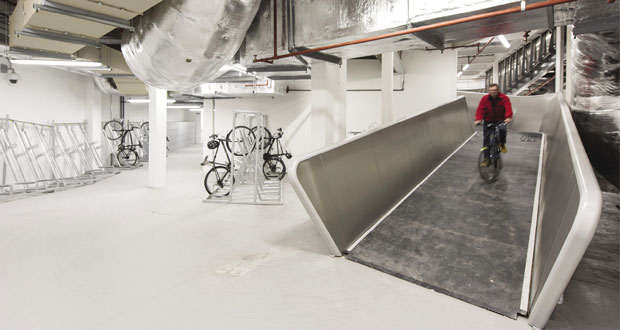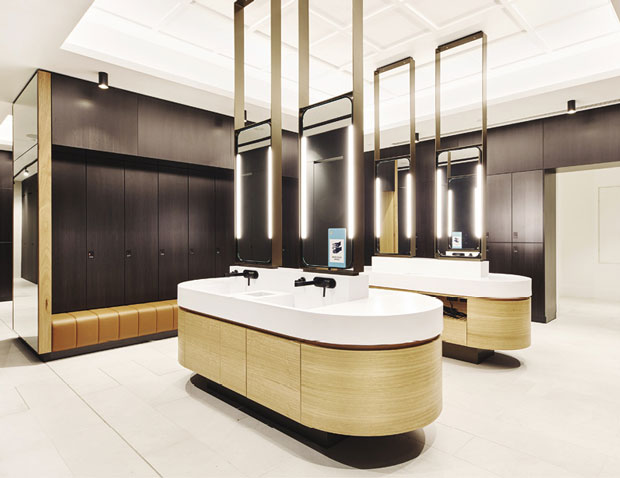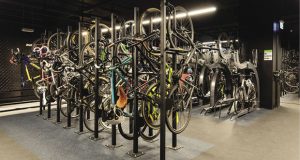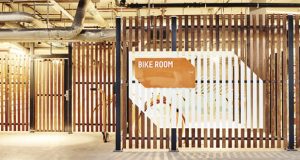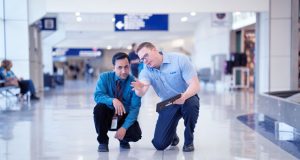ON YOUR BIKE
So, what role is there for the humble bicycle? Is it different enough? “Supporting colleagues’ ability to cycle to work is fundamental for sustainability and Covid-safe travel. With more cycle lanes being introduced as alternatives to public transport and car-sharing, we believe more companies should be actively promoting this to their workforce. Not only does it provide safe travel, but exercise also supports mental and physical health. We are also working with a number of clients to provide more bike lockups and changing rooms, with the right facilities in place it will be more attractive for people to make the move to cycling to work,” said James Mabbett of Atalian Servest.
This is a fine example, but can more be done? Tom Bogdanowicz, Senior Policy and Development Officer, London Cycling Campaign said: “Every employer should be providing an active travel plan for its employees to get to work. Many do, but not enough and right now, despite campaigning by us and other groups like ours across the UK, there is still not enough information about how much easier and safer riding a bike is in our cities now. There’s more to be done, but, for example, the new cycleways running north-south and east-west in London make it possible to ride across the city with a child, as I do, because road danger has been reduced.”
Even before COVID-19 many forward looking offices saw more than 10 per cent of the staff riding a bike to work. During the pandemic riding a bike was so popular shops ran out of bikes to sell and parts for repairs.
Bogdanowicz continued, “The potential for cycling is obviously much higher than it is. TfL estimates an additional eight million cycle trips per day could be made in London. And cargo-bikes have increased in numbers now that they have electric assistance and can carry loads all day without getting too tired. The stigma of cycling has reduced and it’s no longer unusual to see an estate agent arriving at a property by bike and there is no shame in parents taking a child to school by bike. Some gardeners get around by cycle (no parking problems) as do workmen once they’ve delivered their tools.”
There’s a business opportunity for FMs and it’s complicated. Theo Nicolaou of SmartSec Solutions said: “In June, we also saw a significant increase in the number of cycle racks installed in our client sites – up by 30 per cent in some instances. However, there are obstacles to this from a security perspective. Many of the buildings we support have closed their shower facilities because their risk assessments require them to sterilise or deep clean them between use and this is seen as impractical. Therefore, people cycling to work aren’t able to have showers and this sometimes triggers unsavoury behaviour born out of sheer frustration.”
Steve Brewer observed that people just don’t like communal showers. Good end of route facilities will always encourage an active route to work. “In a multi-tenanted building you might have more people using showers than in an average gym. We see demand for dedicated facilities for each occupier – but generally developers and architects don’t design this in. It is a refurbishment project.”
“To help people stay safe and be confident about taking an active route to work we need to know what kind of journeys staff are making. If any employer, not just FMs, can make a risk assessment for their people it’s a big start,” says Dr Rachel Aldred, Professor of Transport and Director of Westminster University’s Active Travel Academy. “If organisations think through all of the options then people can move about in a low carbon, socially distanced manner but it needs planning.
Mitie appear to be doing this, Jasmine Hudson explains: “Since the lockdown, we’ve also held two application windows for our Cycle to Work scheme, to support our colleagues looking to get healthy, help the planet and avoid public transport. We’ve tripled the allowance to £3,000 so that everyone can get the bike and kit they need to travel to work safely.”
It’s working too. Mitie saw a 57 per cent increase in accepted applications for C2W in 2020 compared with 2019, even allowing for pushing back the window by a couple of months, due to COVID-19.
This is good, but Rachel Aldred and other experts want to see employers to think differently. Dr Aldred and Tom Bogdanowicz agree that not enough information is shared about the potential for reaching work in different ways. The information is out there, but it’s not promoted. Likewise, employers could and should take the opportunity to lobby local authorities about route planning.
“We should all be responding to consultation about installation of footpaths, cycle lanes or whatever is being planned by councils to help create safer, more sustainable and active routes to work. If it affects staff or end users of a workplace reaching their destination then employers have a role to influence that planning decision,” said Rachel Aldred.
No one is actually saying it loud and clear, but the commute to work by car might be over. Depending on where you live it is beginning to feel like a last resort. However, with winter coming and infection rates on the rise will that change – will people return to the car as a default transport bubble?
What’s required is a more concerted effort by FMs and all employers (FM customers) to call for more support for active travel from central and local Government and investment in public transport. It’s clear that it’s happening but we need to see more joined up thinking to support people’s route to work, plus there’s a clear requirement for different attitudes to FM transport logistics. The virus isn’t going away. Low Traffic Neighbourhoods, restricted access to central urban districts, limitations on service vehicles and freight – it is all here to stay.
www.fmj.co.uk/world-green-building-council-celebrates-milestone-in-net-zero-carbon-buildings-commitment
www.fmj.co.uk/covid-19-anxiety-changing-commuter-travel-habits
www.lcc.org.uk/

